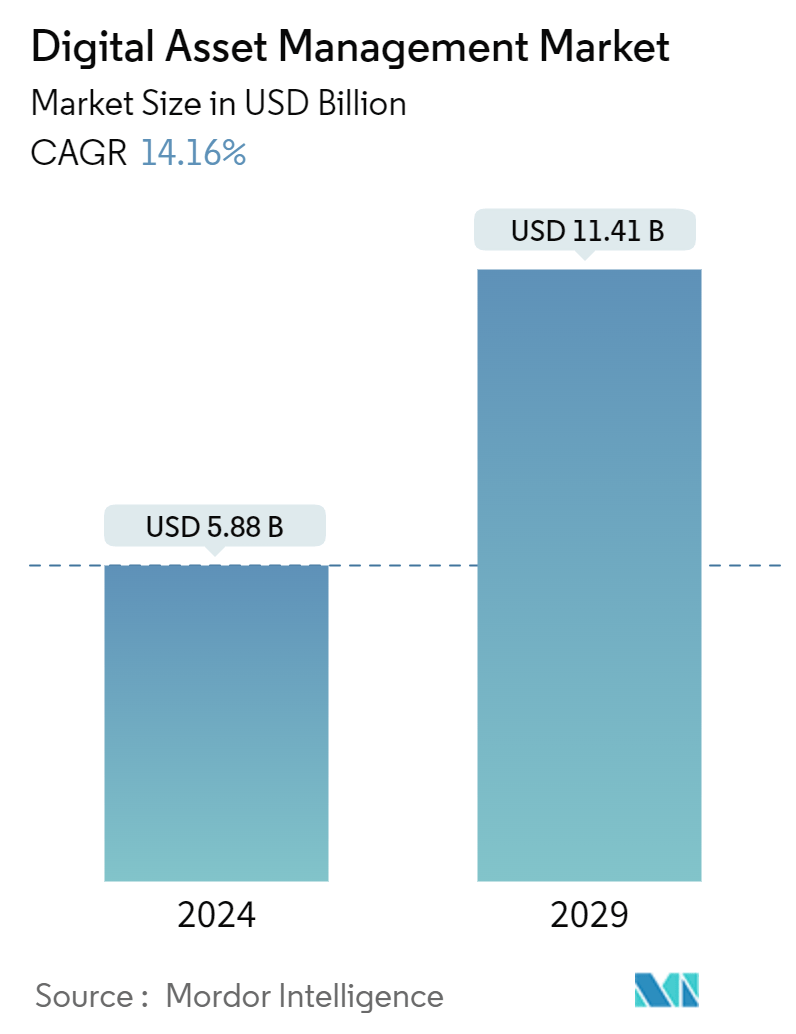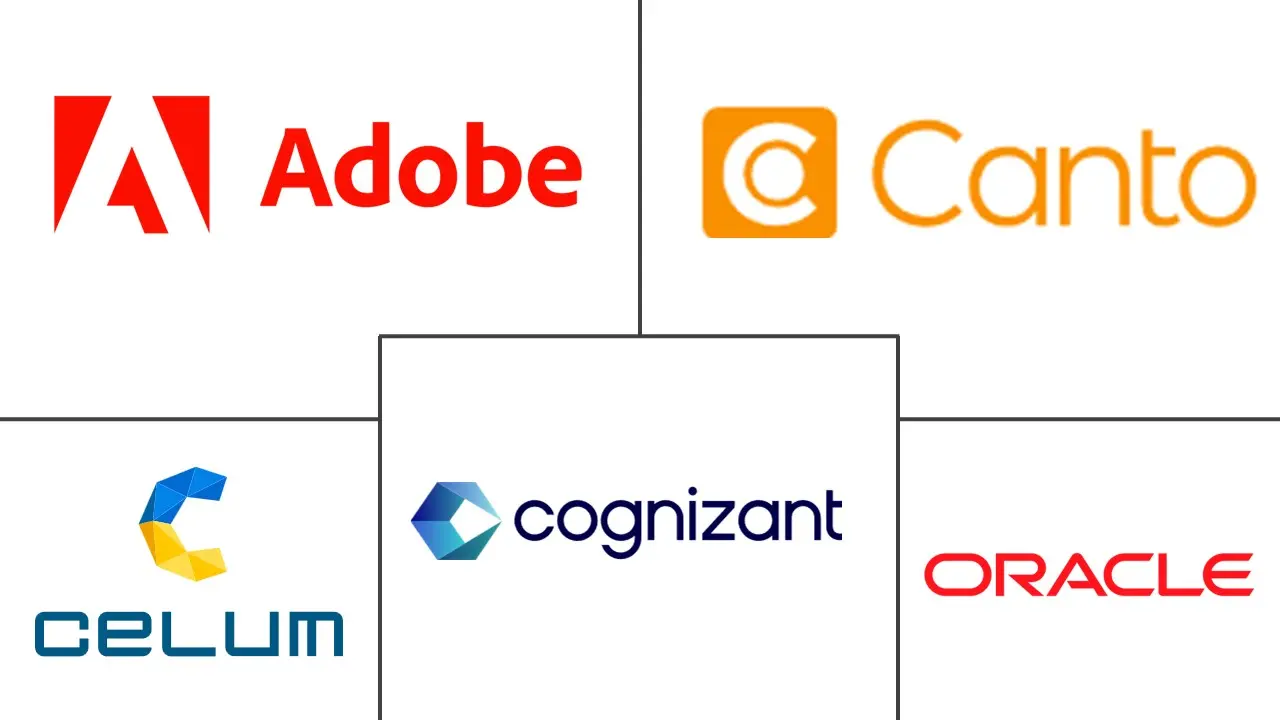Market Size of Digital Asset Management Industry

| Study Period | 2019 - 2029 |
| Market Size (2024) | USD 5.88 Billion |
| Market Size (2029) | USD 11.41 Billion |
| CAGR (2024 - 2029) | 14.16 % |
| Fastest Growing Market | Asia Pacific |
| Largest Market | North America |
| Market Concentration | Low |
Major Players
*Disclaimer: Major Players sorted in no particular order |
Digital Asset Management Market Analysis
The Digital Asset Management Market size is estimated at USD 5.88 billion in 2024, and is expected to reach USD 11.41 billion by 2029, growing at a CAGR of 14.16% during the forecast period (2024-2029).
- With the increasing automation and connected devices trend, digital content has significantly increased over recent years. The growing data volume has created digital assets. Digital assets have become important enough that digital asset management companies are coming on board. DAMs provide digital security for businesses, allowing them to safely store, organize, and instantly access their digital assets. The demand for Digital Assets is growing at an accelerating rate across the different categories. Conventional investors (hedge funds and family offices) in all major markets are increasingly exposed to digital assets. Most investors perceive digital assets positively.
- Further, the growing strategic developments, such as solution launches and collaborations with the growing demand for digital assets, are analyzed to contribute to the market growth rate during the forecast period.
- For instance, in February 2024, Obligate joined forces with Archax in a strategic partnership that was aimed at shaping the digital asset management landscape. A strong ecosystem, promising a complete set of products and services to clients, is created by Obligate's advanced platform for on-chain capital markets in conjunction with Archax's broad range of digital asset management services.
- As part of the collaboration, Obligate clients gain seamless on-ramp access from fiat into digital assets, leveraging Archax's UK-regulated digital asset custody services. The collaboration would offer clients an expanded range of products and services in the field of Digital Asset Management, with both companies expecting a positive impact. Archax, the first company to be regulated by the Financial Conduct Authority as a digital securities exchange, custodian, and broker, will expand its offering of digital assets via Obligate's groundbreaking platform into private market securities.
- However, there is a lack of awareness about the available solutions in the market as many companies still use older enterprise content management platforms with some DAM-like capabilities but do not necessarily have purpose-built DAM solutions for creative services or marketing use cases that are required for their organizations.
- Since the outbreak of the pandemic, the digital agenda worldwide has witnessed a newfound growth in adoption, pushing businesses to adopt digital-first strategies. COVID-19 has caused significant disruption to business on a global scale and accelerated the growth of cyber-criminal activities in private and government enterprises supported by digital transformation.
Digital Asset Management Industry Segmentation
The study tracks the key market parameters, underlying growth influencers, and major vendors operating in the industry, which supports the market estimations and growth rates over the forecast period. The study also tracks the revenue accrued from the solutions used by various end users across the globe. In addition, the study provides the digital asset management market trends, along with key vendor profiles. The study further analyses the overall impact of COVID-19 on the ecosystem.
The digital asset management market is segmented by deployment (on-premise, cloud (SaaS)), organization size (SMEs (small and medium enterprises), large enterprises), end user (media and entertainment, BFSI, government, healthcare, retail, manufacturing, and other end users), and geography (North America [United States and Canada], Europe [United Kingdom, Germany, France, and Rest of Europe], Asia-Pacific [China, Japan, India, and Rest of Asia-Pacific], Rest of the World [Latin America and Middle East and Africa]). The report offers market forecasts and size in value (USD) for all the above segments.
| By Deployment | |
| On-premise | |
| Cloud (SaaS) |
| By Organization Size | |
| SMEs (Small and Medium Enterprises) | |
| Large Enterprises |
| By End User | |
| Media and Entertainment | |
| BFSI | |
| Government | |
| Healthcare | |
| Retail | |
| Manufacturing | |
| Other End Users |
| By Geography | ||||||
| ||||||
| ||||||
| ||||||
| Rest of the World (Latin America and Middle East and Africa) |
Digital Asset Management Market Size Summary
The digital asset management (DAM) market is poised for significant growth, driven by the increasing volume of digital content and the need for secure, organized, and easily accessible digital asset storage solutions. As businesses continue to adopt digital-first strategies, particularly in the wake of the pandemic, the demand for DAM solutions has surged. These solutions are crucial for managing the growing influx of digital assets across various sectors, including marketing, sales, and product development. The rise of cloud-based deployments has further propelled market expansion, offering centralized, online databases that enhance collaboration and streamline workflows. This shift to cloud services, such as IaaS, PaaS, and SaaS, has made it easier for organizations to manage their digital assets efficiently, improving productivity and operational efficiencies.
In the United States, the DAM market is characterized by the integration of advanced technologies and a strong presence of major vendors, which has led to a significant market share. The adoption of AI and machine learning capabilities in DAM solutions is a key trend, with companies like Cloudinary and Canto introducing innovative features to enhance asset management. Similarly, the Canadian market is experiencing growth due to the increasing volume of digital assets and the need for centralized management solutions. The market is highly fragmented, with major players such as Adobe Inc., Canto Inc., and Oracle Corporation adopting strategies like partnerships and acquisitions to strengthen their offerings. These developments, along with strategic collaborations and technological advancements, are expected to drive the DAM market's growth in the coming years.
Digital Asset Management Market Size - Table of Contents
-
1. MARKET DYNAMICS
-
1.1 Market Drivers
-
1.1.1 Increase in the Number of Digital Assets
-
-
1.2 Market Challenges
-
1.2.1 Lack of Awareness and Higher Costs of the Solutions
-
-
1.3 Key Product Features
-
1.3.1 Video Management
-
1.3.2 Creative Tool Integration
-
1.3.3 Asset Analytics
-
1.3.4 Web Content Integration
-
1.3.5 Brand Portals
-
1.3.6 Asset and Metadata Archiving
-
1.3.7 Lifecycle and Rights Management
-
-
-
2. MARKET SEGMENTATION
-
2.1 By Deployment
-
2.1.1 On-premise
-
2.1.2 Cloud (SaaS)
-
-
2.2 By Organization Size
-
2.2.1 SMEs (Small and Medium Enterprises)
-
2.2.2 Large Enterprises
-
-
2.3 By End User
-
2.3.1 Media and Entertainment
-
2.3.2 BFSI
-
2.3.3 Government
-
2.3.4 Healthcare
-
2.3.5 Retail
-
2.3.6 Manufacturing
-
2.3.7 Other End Users
-
-
2.4 By Geography
-
2.4.1 North America
-
2.4.1.1 United States
-
2.4.1.2 Canada
-
-
2.4.2 Europe
-
2.4.2.1 United Kingdom
-
2.4.2.2 Germany
-
2.4.2.3 France
-
2.4.2.4 Rest of Europe
-
-
2.4.3 Asia-Pacific
-
2.4.3.1 China
-
2.4.3.2 India
-
2.4.3.3 Japan
-
2.4.3.4 Rest of Asia-Pacific
-
-
2.4.4 Rest of the World (Latin America and Middle East and Africa)
-
-
Digital Asset Management Market Size FAQs
How big is the Digital Asset Management Market?
The Digital Asset Management Market size is expected to reach USD 5.88 billion in 2024 and grow at a CAGR of 14.16% to reach USD 11.41 billion by 2029.
What is the current Digital Asset Management Market size?
In 2024, the Digital Asset Management Market size is expected to reach USD 5.88 billion.

